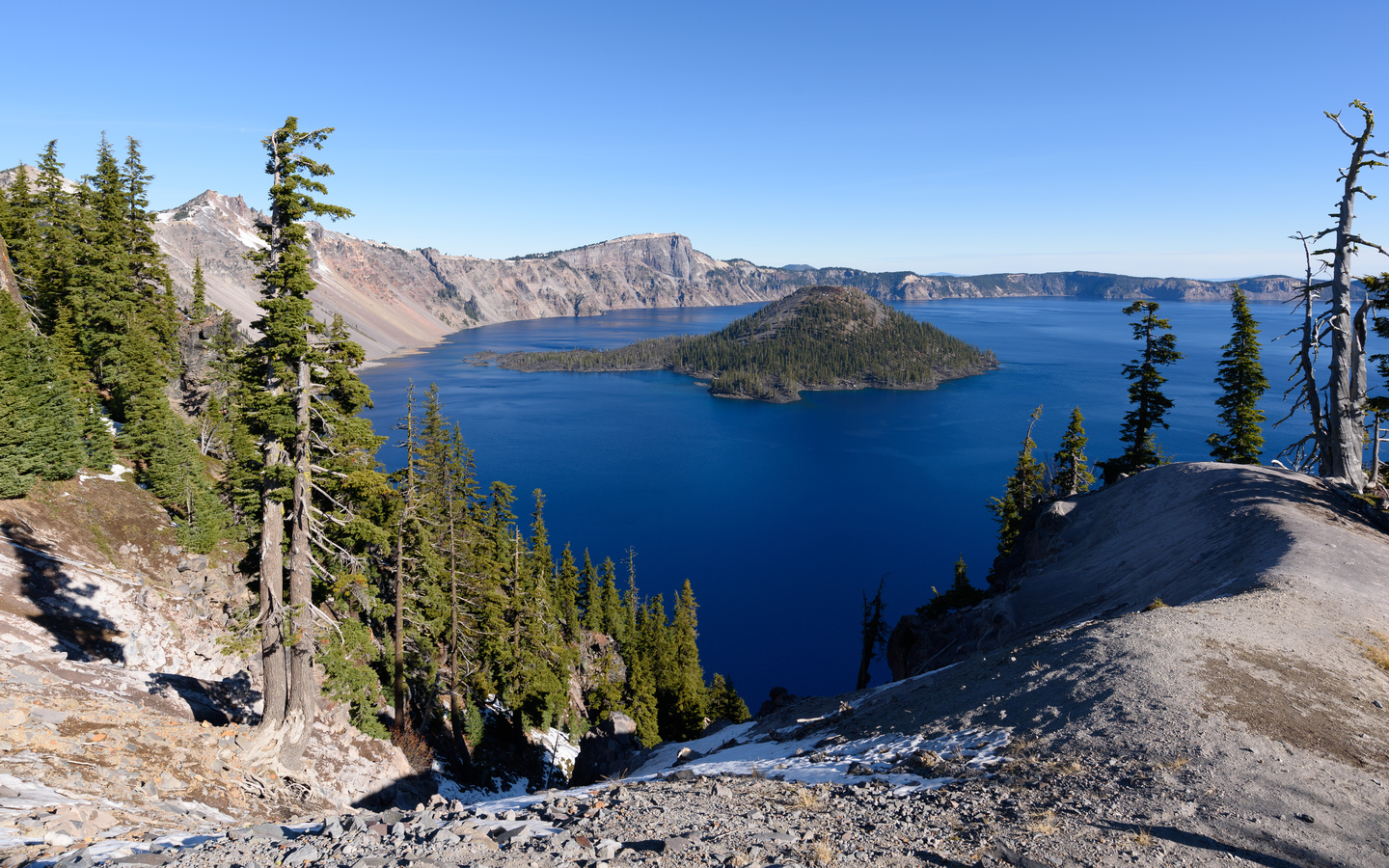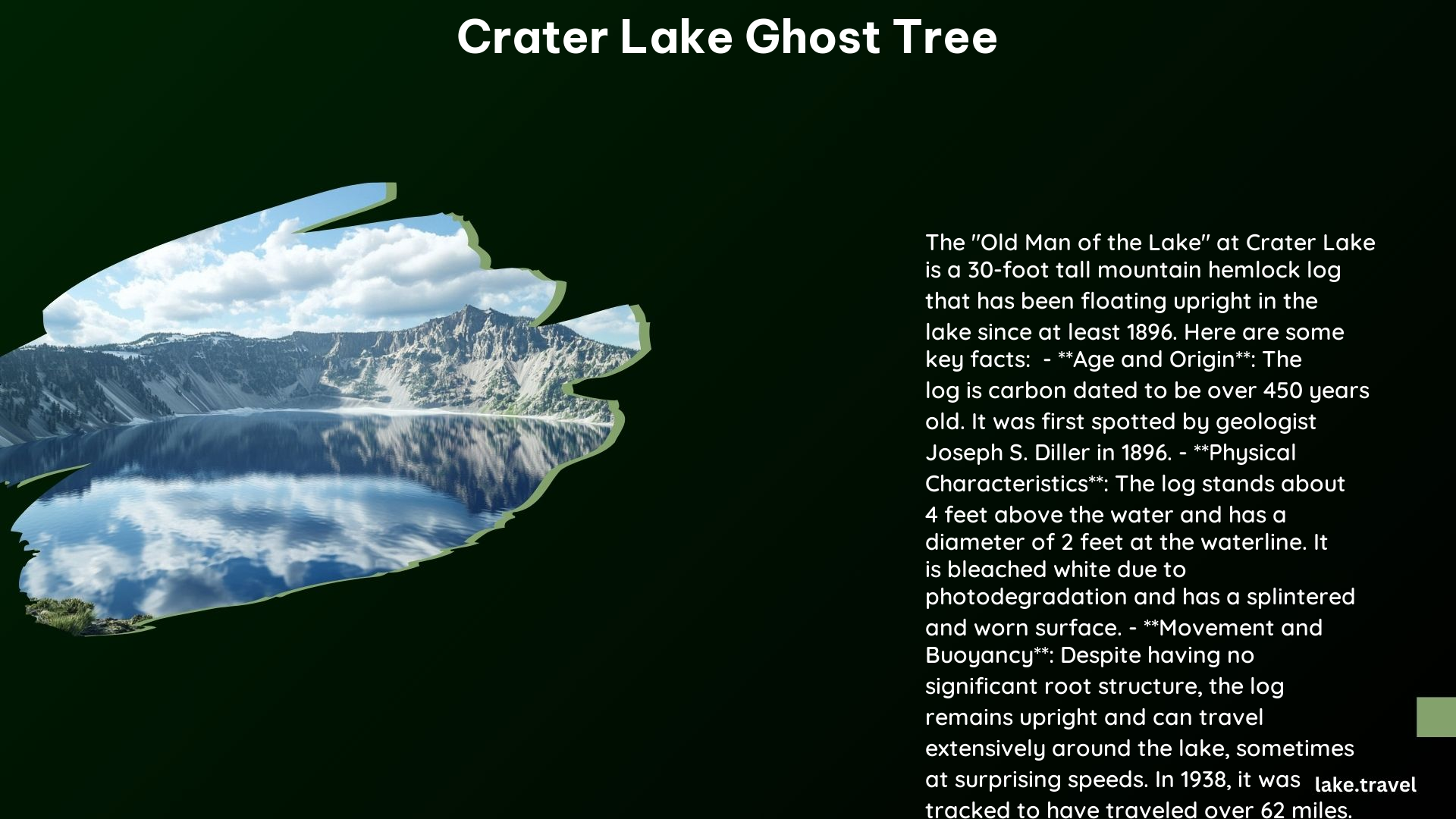The Crater Lake ghost tree, known as the Old Man of the Lake, is a 30-foot tall hemlock stump that has been floating vertically in Crater Lake for over a century. This enigmatic natural phenomenon has captivated visitors and scientists alike with its ability to remain upright and mobile despite its size. The Old Man’s weathered, sun-bleached appearance and mysterious origins have made it a symbol of Crater Lake’s unique ecosystem and a subject of local legends.
What Is the Crater Lake Ghost Tree?

The Crater Lake ghost tree, officially called the Old Man of the Lake, is a remarkable natural phenomenon that has intrigued visitors and scientists for over a century. This unique feature is a 30-foot (9 meters) tall tree stump, believed to be a mountain hemlock, that floats vertically in Crater Lake. What makes it truly extraordinary is that approximately 3-4 feet (0.9-1.2 meters) of the stump remains exposed above the water surface, while the rest is submerged.
Key characteristics of the Old Man of the Lake include:
- Diameter: About 2 feet (61 cm) at the waterline
- Appearance: Sun-bleached white, splintered, and worn above water
- Buoyancy: Capable of supporting a person’s weight
- Mobility: Can travel extensive distances across the lake, especially on windy days
The submerged portion of the trunk is remarkably well-preserved due to the cold, clean waters of Crater Lake. This preservation has allowed the Old Man to remain intact for centuries, making it a fascinating ecological anomaly and a symbol of the lake’s unique environment.
How Did the Crater Lake Ghost Tree Come to Be?

The origins of the Crater Lake ghost tree are shrouded in mystery, but scientists have developed theories based on observations and studies. The most widely accepted explanation for how the Old Man of the Lake came to be is as follows:
- Landslide Entry: A massive landslide on the crater wall likely carried the tree into the lake.
- Initial Stabilization: Rocks trapped in the tree’s root structure initially kept it upright and stable in the water.
- Root Decay: Over time, the roots decayed, and the rocks fell off.
- Waterlogging: The trunk became waterlogged, allowing it to remain afloat in its vertical position.
While this theory explains the tree’s entry into the lake, it doesn’t fully account for its longevity. Preliminary carbon dating suggests that the tree itself is at least 450 years old, though it’s uncertain how long it has been floating in Crater Lake.
What Makes the Crater Lake Ghost Tree So Unique?
The Crater Lake ghost tree stands out as a truly unique natural phenomenon for several reasons:
- Vertical Orientation: Unlike most floating logs, the Old Man maintains a vertical position in the water.
- Mobility: Despite its size, the tree stump can travel significant distances across the lake, particularly on windy days.
- Longevity: The tree has been observed floating in the lake for over a century, with its actual age potentially much greater.
- Ecological Niche: It serves as one of the few near-surface habitats for the moss Fontinalis in Crater Lake.
- Cultural Significance: The Old Man has become a local celebrity, inspiring legends and superstitions among visitors and locals alike.
These factors combine to make the Crater Lake ghost tree a subject of fascination for both scientists and tourists, contributing to its status as an iconic feature of Crater Lake National Park.
How Far Can the Crater Lake Ghost Tree Travel?
One of the most intriguing aspects of the Crater Lake ghost tree is its ability to move across the lake’s surface. Despite its considerable size and weight, the Old Man of the Lake is surprisingly mobile. Here are some key facts about its travel capabilities:
- Wind-Driven Movement: The tree’s mobility is primarily influenced by wind patterns on the lake’s surface.
- Recorded Distance: In 1938, researchers observed the Old Man traveling over 62 miles between July 1 and September 30.
- Daily Variations: The tree’s position can change significantly from day to day, making it a dynamic feature of the lake.
This table illustrates the potential movement of the Crater Lake ghost tree over different time periods:
| Time Period | Potential Distance Traveled |
|---|---|
| Daily | Up to several miles |
| Weekly | 10-20 miles |
| Monthly | 30-60 miles |
| Seasonally | Over 100 miles |
The tree’s mobility adds an element of unpredictability to its presence in the lake, making each sighting a unique experience for visitors.
What Role Does the Crater Lake Ghost Tree Play in the Lake’s Ecosystem?
While the Crater Lake ghost tree may seem like a mere curiosity, it actually plays a subtle but important role in the lake’s ecosystem:
-
Moss Habitat: The Old Man is one of the few places near the surface of Crater Lake where the moss Fontinalis grows. This moss is typically found at much greater depths in the lake.
-
Microhabitat Creation: The tree’s surface, both above and below water, provides a unique microhabitat for various aquatic organisms.
-
Nutrient Cycling: As the tree slowly decomposes, it contributes organic matter to the lake, playing a small but consistent role in nutrient cycling.
-
Indicator of Lake Conditions: The tree’s preservation and longevity serve as indicators of the lake’s unique water quality and temperature conditions.
-
Scientific Study: The Old Man provides scientists with opportunities to study long-term wood preservation in aquatic environments and the effects of a mobile, semi-submerged object on lake ecosystems.
By fulfilling these ecological roles, the Crater Lake ghost tree contributes to the overall biodiversity and health of the lake ecosystem, despite its seemingly inert nature.
How Can Visitors See the Crater Lake Ghost Tree?
For those eager to catch a glimpse of the famous Crater Lake ghost tree, there are several viewing options available:
- Overlooks and Trails:
- Cleetwood Cove Trail: Offers potential sightings from the lakeshore
-
Rim Drive: Various overlooks along this scenic route may provide views
-
Boat Tours:
- Crater Lake Boat Tours: Regular tours that often pass by the Old Man
-
Wizard Island Shuttle: May offer opportunities to spot the tree
-
Ranger-Led Programs:
- Educational talks and walks that sometimes include information about the Old Man
It’s important to note that private boating is prohibited on Crater Lake, so guided tours are the best way to see the Old Man up close. Here’s a quick guide to viewing options:
| Viewing Method | Proximity | Certainty of Sighting |
|---|---|---|
| Overlooks | Distant | Low to Moderate |
| Boat Tours | Close | High |
| Ranger Programs | Varies | Moderate |
Remember that due to the tree’s mobility, its exact location can vary, adding an element of excitement to the search for this natural wonder.
What Legends and Superstitions Surround the Crater Lake Ghost Tree?
Over the years, the Crater Lake ghost tree has become the subject of various legends and superstitions:
-
Weather Control: Some believe that the Old Man has the power to control the lake’s weather patterns.
-
Good Luck Charm: Touching or climbing onto the tree is thought by some to bring good fortune.
-
Guardian Spirit: Local legends sometimes portray the Old Man as a guardian spirit of the lake.
-
Predictive Powers: Some visitors claim that the tree’s position can predict future events or conditions at the lake.
-
Immortality: The tree’s longevity has led to myths about its supposed immortality or magical properties.
While these beliefs are not scientifically supported, they add to the mystique and cultural significance of the Crater Lake ghost tree, enhancing its appeal to visitors and contributing to its status as a beloved local icon.
How Has Scientific Study of the Crater Lake Ghost Tree Evolved?
Scientific interest in the Crater Lake ghost tree has grown since its first recorded observation in 1896:
- Initial Documentation:
-
1896: First recorded by geologist Joseph S. Diller
-
Early Studies:
-
Early 1900s: Basic observations of the tree’s movement and characteristics
-
Detailed Tracking:
-
1938: Comprehensive study of the tree’s movement patterns over three months
-
Modern Research:
- Carbon dating to determine the tree’s age
- Analysis of wood preservation in the lake’s unique environment
-
Studies on the tree’s impact on local ecology
-
Ongoing Monitoring:
- Regular observations by park rangers and scientists
- Integration into broader studies of Crater Lake’s ecosystem
This evolution of scientific study has transformed the Old Man from a curious anomaly into a valuable subject for understanding long-term processes in aquatic environments and the unique conditions of Crater Lake.
What Conservation Efforts Protect the Crater Lake Ghost Tree?
While the Crater Lake ghost tree is a natural phenomenon that largely takes care of itself, several conservation efforts help protect it and its environment:
- Boating Restrictions:
-
Private boating is prohibited on Crater Lake, reducing potential damage to the Old Man.
-
Education Programs:
-
Park rangers educate visitors about the tree’s significance and the importance of not disturbing it.
-
Monitoring:
-
Regular observations track the tree’s condition and movement.
-
Water Quality Protection:
-
Efforts to maintain Crater Lake’s pristine water quality indirectly benefit the Old Man’s preservation.
-
Research:
- Ongoing studies help inform conservation strategies and increase understanding of the tree’s role in the ecosystem.
These efforts ensure that the Crater Lake ghost tree remains a fascinating feature of the park for future generations to observe and study.
In conclusion, the Crater Lake ghost tree, or Old Man of the Lake, stands as a testament to the unique and often mysterious natural phenomena that can occur in protected environments like Crater Lake National Park. Its longevity, mobility, and the legends surrounding it make it not just a scientific curiosity, but a cultural icon that enhances the visitor experience and contributes to the rich tapestry of stories that make up America’s natural heritage.
References:
1. The Old Man – Crater Lake – National Park Service
2. The Old Man of the Lake – National Parks Conservation Association
3. Old Man of the Lake – Wikipedia
